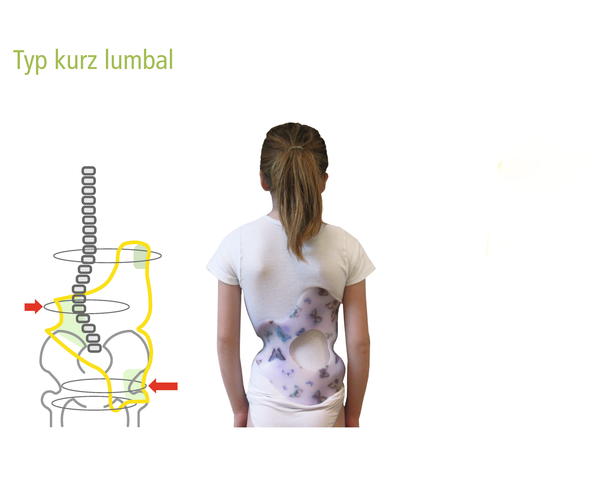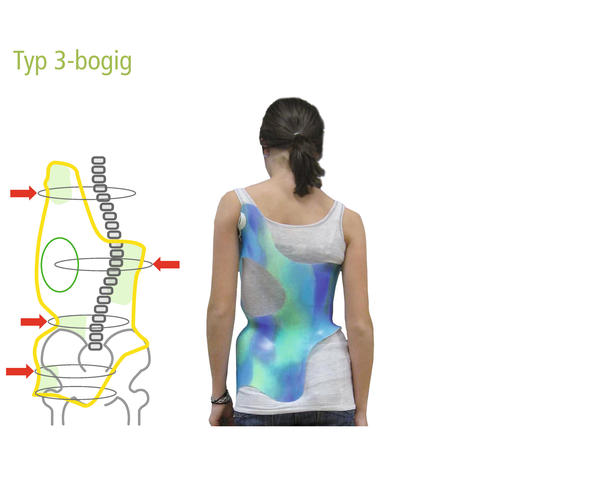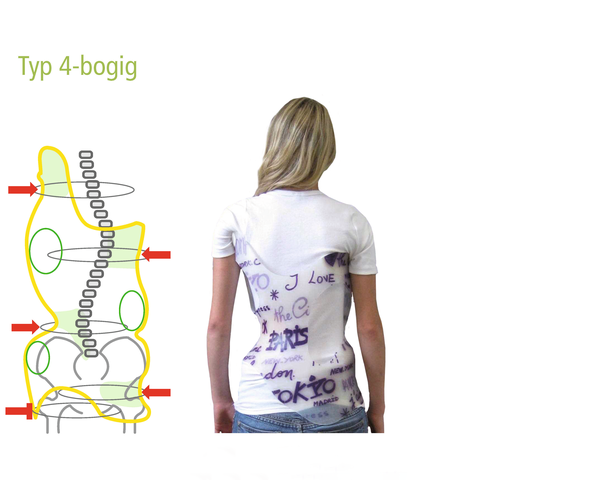A corset is an orthosis that fits around your torso used to correct spinal deformities.
We train you in the everyday use of your corset.
Make an appointment over the phone or send us a message!

Initial Consultation
Spinal radiographs should be taken if the physician’s physical examination indicates scoliosis. This is the only way to identify the type and extent of scoliosis.
The x-ray image will be used by the physician to measure the lateral curvature based on the Cobb technique (named after the scoliosis classification of John Robert Cobb). The extent of the curvature determines the further course of treatment, the diagnosis, and the necessity of a corset.
If a corset is required, the doctor together with the orthopedic technician will determine the type of corset and the treatment concept. During the information meeting, you will also be informed about the different forms of physiotherapy and the use of the corset.
How many curves?
These three types of corset are available
The corset is made of elastic plastic and is custom-fit around your torso. The defined waistline creates the necessary pressure needed to straighten your spine. The corset usually extends from the pelvis to the chest. It is supported at the pelvis in order to continue the correction upwards along the spine. At the chest, correction takes place via the ribs, which are directly connected to the vertebral bodies. By adding pressure to the ribs, the vertebral bodies can be de-rotated and straightened.
The type of corset you need is determined by the number of curves that your spine has. The curves can be clearly seen on the x-ray image. A distinction is made between scoliosis with three or four curves and scoliolis with one curve in the lumbar region of the spine.



Your path to a corset
If your doctor notices scoliosis, he or she will take an X-ray of your spine. If you need a corset (day brace or night time bending brace), you are free to choose the orthopedic company where you would like to have your brace made. If you choose us, you make an appointment for a consultation at Pohlig and bring your prescription with you to this appointment. We will inform you in an initial meeting about the corset treatment and possible forms of physiotherapy.
As soon as we receive your prescription, we will prepare a cost estimate and submit it together with the prescription to your health insurance company. The approval process usually takes a maximum of 4 weeks. Within this time, the health insurance company must have sent either an approval or a rejection letter to your parents. In case of a refusal to cover the costs, you can file an appeal.
If you are insured with a private health insurance company and/or are entitled to a subsidy, your parents will receive a cost estimate. Based on this, it will be clarified individually what amount will be covered by the health insurance.
Using the SimBrace® process, we can simulate the fit and function of your corset in advance. To do this, you will first be placed in a special appliance. Together with a physiotherapist, we determine the optimal position of your spine. Then, we use the appliance to hold you in this position and scan this corrected body position. The result is a 3D model of your torso from which we produce the actual corset.
For optimal wearing comfort, we make corrections to the corset shape and determine the position of the correction pads.
At first, wearing a corset creates a rather unusual feeling. The body can tense up initially and tends to resist the correction, instead of gently adapting to it. Our physiotherapists will help you choose the type of therapy for your home and discuss the options for designing your day-to-day activities, including school and leisure.
You need time to familiarize yourself how your body feels in the corset. Acceptance within your social environment also plays an important role. It is important that your friends and family are made familiar with the new situation. Your therapist will help you get the most out of your movement with the corset. The aim is to move the spine and make the muscles supple so that the correction pressure of the corset can be pain-free. You should also learn to breathe into the space inside the corset to reinforce the correction.
It is important to check your posture regularly during the day. Talk to your physiotherapist about how and when you can integrate corrective movement into your daily life.

The sisters Clara and Marina both have scoliosis and therefore wear a corset. They explain to you how they deal with their diagnosis and the daily wearing of a corset.
Physiotherapy for corset wearers
In the series “Scoliosis? Ask Melli!" our physiotherapist Melli explains the different types of scoliosis and shows you practical exercises that you can do at home.
Corset
Frequently asked questions
The wearing time of the corset is determined by the attending physician. It can vary between 16 and 23 hours. In most cases, sport counts as wearing time. However, you should clarify with your doctor what exactly is meant by "sport". For example, jumping into the lake from time to time on a hot summer day does not count as exercise. Other exceptions (vacation, amusement park, etc.) that deviate from the standard wearing time of a corset should also be discussed with your doctor in advance.
The NTBB corset according to Charleston Bending is a specific form of corset fitting. In contrast to a corset for the day (day supply), the NTBB is a pure night supply and works by overcorrecting the spine.
Figuratively speaking, one lies in a "banana shape" in a NTBB: the spine is corrected in exactly the opposite direction as the actual scoliosis runs. In this way, one tries to achieve the maximum correction possible while lying down.
Since NTBB is an overcorrection, the brace can only be worn during the night. In the non-recumbent state, the correction of an NTBB would be too strong. Therefore, depending on the strength of the angle of curvature of the scoliosis, a brace may additionally be prescribed for the day.
Usually, the statutory or private health insurance covers the costs of a corset fitting. The prices of a corset differ depending on the type of corset and the way it is made.
Playing sports is generally possible with scoliosis and is often even expressly recommended by physiotherapists and doctors. Sports that additionally support the physiotherapeutic exercises and thus train and strengthen the trunk muscles are particularly suitable.
As a rule, the corset should not be worn during sports activities. Nevertheless, sports are generally included in the "wearing time" of a corset.
A very suitable sport to support the trunk muscles is swimming. Swimming strengthens the entire trunk musculature. Moreover, this kind of sport relieves all joints at the same time and there are no jerky movements. Especially backstroke or back crawl and breaststroke are suitable for scoliosis.
Another sport that is excellent for scoliosis is climbing. During climbing, the entire trunk musculature is also tensed in a controlled manner and many stretching and straightening movements are performed.
Despite the impact-like stress on the spine, jogging is not forbidden in scoliosis. However, care should be taken to ensure that the majority of the distance is covered on a soft surface and not on hard asphalt paths. In order to find suitable running shoes that are as shock-absorbent as possible, it may be useful to seek advice from a specialist sports store.
Other popular sports for scoliosis include therapeutic horseback riding, hiking and cycling.
As far as school sports are concerned, questions come up very often for scoliosis patients. School sports are usually considered carrying time. It is not mandatory to obtain a school sports exemption - unless you are affected by such severe scoliosis that you should not participate in sports as a matter of principle. If you have individual questions about sports with scoliosis, you should consult your attending physician.
Particularly during the adjustment period, many affected children and adolescents are not very familiar with their new situation and do not want anyone outside their immediate family to know that they are wearing a brace. In this case, many proceed in such a way that they leave the corset at home during the first 2-3 weeks on the days when sports are on the schedule. The corset is then only put on after school and left on overnight in order to still achieve the longest possible wearing time.
The end of a corset therapy is determined by the attending physician. In most cases, the corset is untrained at the age of 16 for girls and at the age of 17 for boys.
As a rule, the unschooling proceeds in such a way that the daily wearing time is gradually reduced by one hour. The doctor and patient decide together how quickly the wearing time should be reduced. At the end of corset therapy, the corset is usually worn at night for another four to six months. Approximately one year after wearing the brace, an X-ray of the spine is taken to find out whether the angle of curvature could be kept stable.
Clothing, wearing schedule, therapy
Sophia answers your questions
How does it feel to wear a corset? How regularly do you have to go to the doctor, the physiotherapist or the orthopedic technician? Have you already thought about surgery? 17-year-old Sophia has an answer to these and many other questions. Sophia would like to become a physical therapist when she grows up and help other patients with spinal deformities.

Let yourself be inspired! We follow many interesting patients during their Pohlig appointment and give you personal insights.

For those who want to delve even deeper into the subject, we have a suitable video for almost every area of treatment!

Take a look behind the scenes at Pohlig and learn about different health conditions and our innovative assistive technology solutions!

Sometimes funny, sometimes explanatory, sometimes emotional - but above all always entertaining: our videos on TikTok!
Everything simulated?
SimBrace® – our new digital scanning technology
Nathalie and Selina show you how SimBrace® works. This is a newly developed process in which the correction of the corset can be simulated before production. This method eliminates the need for a plaster cast!




